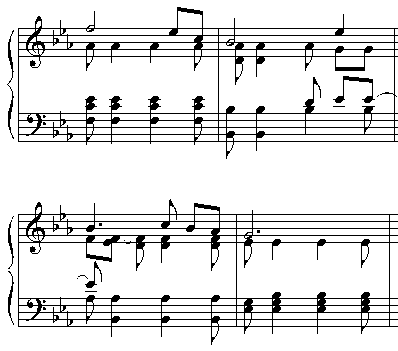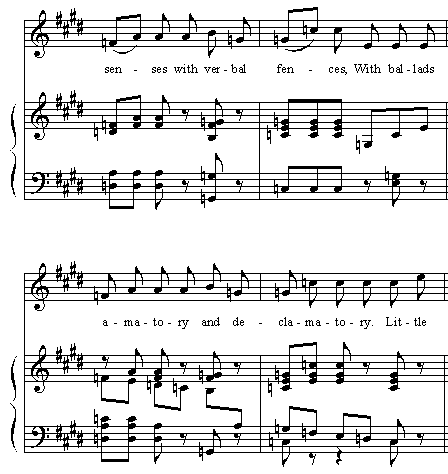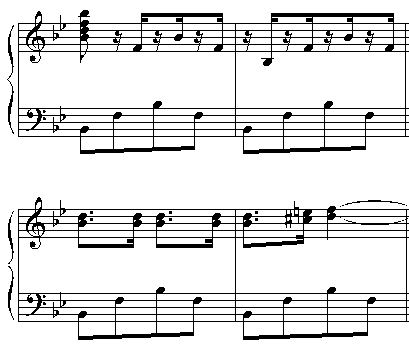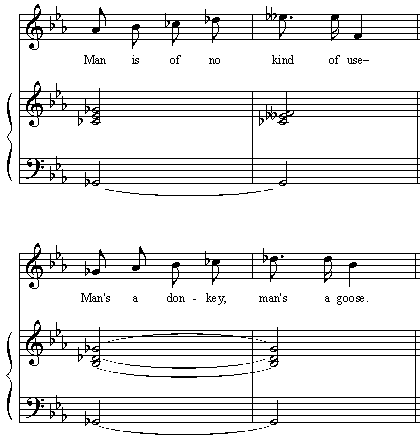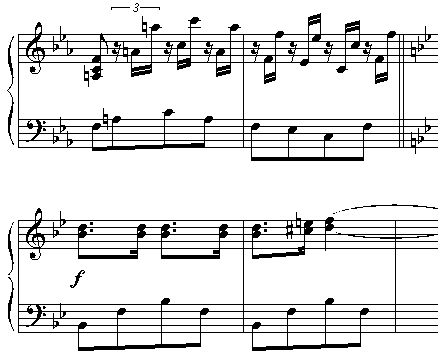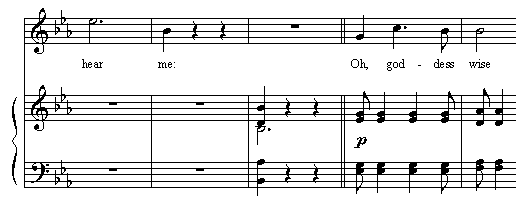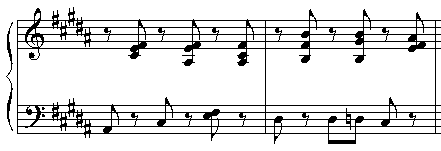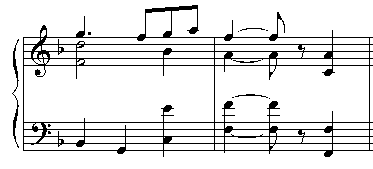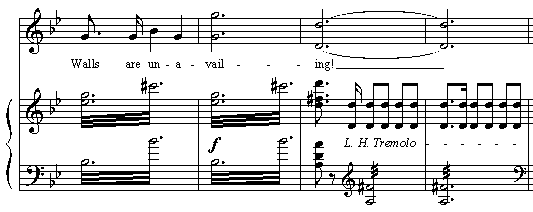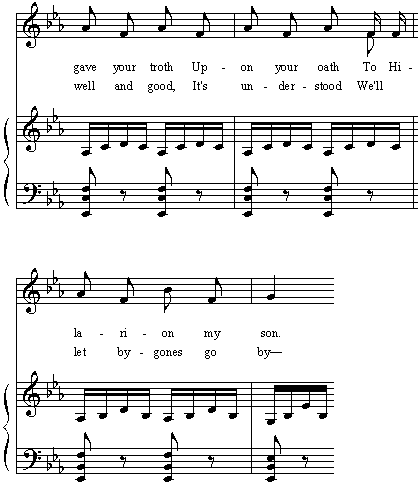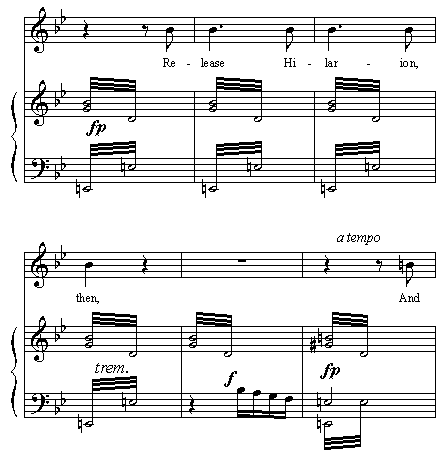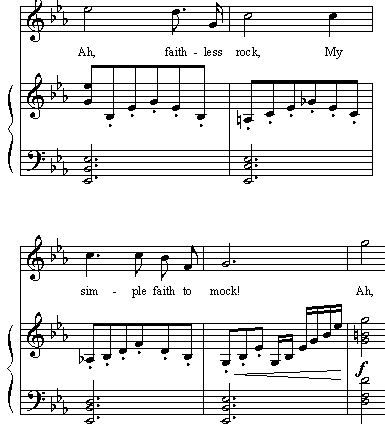 |
 |
||||||
ERRATA LIST FOR THE CHAPPELL VOCAL SCORE
OF PRINCESS IDA
2. ERRORS/ISSUES IN THE PIANO PART
| SP: 3/6/6 LP: 4/5/4 |
LH, n1-4: Chord should be Fmin7 (F-Ab-C-Eb). The arrangement omits the Eb, making it F minor. The following shows the correct harmony, with adjustments made for correct voice-leading:
|
SP: 7/2/6 |
LH, n3: Instead of a quarter note C, there should be two eighth notes on C-Eb, in parallel tenths with the RH. |
SP: 13/1/1 |
Piano: The forte mark should be on the pickup to this bar ("He'll" of "He'll trounce them both"), as in the analogous bar in the first verse (where the forte mark was on "To" of "To your command on every hand"). |
SP: 15/2/2 |
RH, n1: There should be no chord change on this beat. Instead, the previous whole note (all three notes in the chord) should tie into this bar. |
SP: 15/3/6 |
RH, n1-2: The notation suggests movement from the G on beat 1 to the Eb on beat 3. Actually, nothing happens. It should simply be a dotted half on both G and Eb, together with the lower G in the same clef. |
SP: 15/5/5 |
Piano: The "piano" mark seems unnecessary since the dynamic hasn't changed since the "piano" at the double bar three bars earlier, and there's another "piano" in the very next bar. It looks particularly bad in LP, where both "piano" marks are both on the same page, right next to each other, whereas in SP the second "piano" mark is at the top of the page after a page turn. |
SP: 25/3/4 |
RH, n7: Lower pitch should be E-natural, not G (a third lower than printed), as in verses 2-3. |
SP: 29/3/6 |
Piano, n2: The printed chord is E-G#-B-F (on "your" of "but your doing you must do"). The chord in the analogous bar of the chorus repeat is E-A-B-F (the tenors move from G# to A, the piano doubling this motion). Other than this one note, the accompaniment is identical between the solo and chorus sections (same situation in second verse). Either this measure or the chorus repeat bar is likely incorrect, as both bars were probably intended to match. According to Larry Byler, the viola part has G# in both places, which would indicate that the tenors' A is incorrect. Marc Shepherd confirms that the autograph shows an abbreviated sign indicating a literal repeat of the orchestration, but that the A is also present in the tenor part. Clearly an oversight on Sullivan's part. If the A is performed by the tenors, the viola part should certainly follow suit. The G#-A line seems to work well enough, matching the sopranos' movement on E-F. However, a case could also be made for having the tenors sing G#, as it matches what they have been singing in the previous two phrases, remaining on the third of the chord for the entire measure in each case. Ultimately, it will be up to the music director to see that the discrepancy is resolved in a suitably harmonious fashion. |
SP: 30/2/6 |
Piano: Starting with this bar, there are three bars of orchestra intro to the second verse, instead of four bars as in the first verse. An uneven number of intro bars seems an unusual choice on Sullivan's part; a more "normal" abbreviation would have been to make it two bars. Nevertheless, the autograph confirms that Sullivan intended three for the second verse. Savoynetter Edwin Nealley suggests that perhaps " Sullivan was simply inserting a little musical joke/character coloring here. Gama (who was keeping everyone waiting earlier while he made a dramatic entrance) takes a full four bars, but Hildebrand, the 'pepp'ry' King can't wait quite that long and jumps the expected phrase a little." This seems to me as good an explanation as any! Note: D'Oyly Carte traditionally cut two of the introductory measures in both verses, leaving Gama with two bars of intro, and Hildebrand with only one bar. ("Pepp'ry," indeed!) |
SP: 34/2/2 |
Piano: Sullivan wrote a charming bassoon solo (of an "amatory, declamatory" nature) to accompany Florian's lyrics. It can be easily interpolated into the accompaniment, as follows:
|
SP: 35/3/2 |
RH, n2-4: This three-note group should have staccatos, as in the analogous notes in the next bar. |
SP: 35/3/4 |
RH, n1-3: These three notes should be slurred, as in the analogous notes in the previous bar. |
SP: 42/3/8 |
RH: Play this bar and the next as alternating 16th-notes:
|
| Same at beginning of No. 10a ("Exeunt" music). | |
SP: 44/4/6-7 |
Piano: The chords should surely be spelled as per Psyche's line, for harmonic clarity and improved pianistic legibility:
|
SP: 45/1/1 |
RH: The first triplet should begin on the low octave, as do the analogous triplets (on the second half of beat 1) in the next two bars, in order to avoid repeating the same note at the beginning of the second bar of the pattern. |
SP: 45/1/5 |
RH triplets: The second note in each pattern should be played an octave higher. Much easier and more effective that way:
|
SP: 48/2/2 |
Piano, n1: The French horn plays B-flat on a dotted half note in this bar (one whole step below middle C). It's a very prominent solo, and deserves to be added to the accompaniment.
|
SP: 49/5/2 |
LH, n1: The top note should be a half-note G, not a dotted half, since the third beat begins with an Ab harmony. Undoubtedly, the correct voice-leading is as follows:
|
SP: 50/3/1 |
RH, n3: Bottom note of the chord (C) is missing the natural sign. |
SP: 53/1/3 |
RH, n1: There should be a staccato mark, as on n2. (This error is in SP only, corrected in LP.) In both editions, there should also be some indication that the staccatos continue in the melody for the next seven bars (with the exception of the C major chord on the downbeat of the fifth bar of the phrase). The same staccato articulation occurs in the accompaniment to the opening vocal phrase ("Gently, gently, Evidently… Here, at last, we are!"). |
SP: 53/2/4 |
LH, n8: In the upper voice (played by bassoon), the note should be D, one step higher than written. Playing it would require a minor adjustment of the piano arrangement, as follows:
Note that the bassoon part is also represented inaccurately in the previous bar, on beat 3. The correction is printed above. Both of these changes also apply when the phrase is repeated 22 bars later. |
SP: 66/2/2 |
LH, n3: The printed note is an eighth-note F#, which appears to be correct, as it's played by the cellos. However, the bassoon also plays a quarter-note E one step lower than the cellos, as part of an ongoing line that was not included in the accompaniment. For that beat, at least, the bassoon part has a significant harmonic purpose, as it changes the chord to the third inversion of the dominant seventh chord, leading naturally to the first inversion of the tonic chord. Perhaps a good way of notating it for the piano reduction would be simply to add the E to the F# as a "double-stop," as part of the existing eighth-note:
The bassoon E is not repeated when the four singers repeat the phrase later in the song. Note that with this arrangement, the final RH chord in the first bar shown above should contain a C# as shown, rather than an E as in the score, to avoid doubling the seventh. |
SP: 74/1/3 |
RH, n5: The forte mark should be on n4, and there should be a slur mark between n4 and n5. Same situation in the second verse. The LP edition, carelessly, shows two forte marks on the same beat. |
SP: 81/3/3 |
RH, n2: Beginning with the third beat, the RH should be played an octave higher through the end of the second-to-last bar, playing as written only on the final chord. |
SP: 82/1/4 |
RH, n1: The note value assigned to the stems-down "double-stop" F-D is incorrect. The harmony of the passage (not to mention the size of most pianist's hands) makes it impossible for these notes to be held for a dotted-half note as printed. The simplest fix would be to remove the dots, making them both regular half notes. This is the way it's printed in the final playout in SP (both editions repeat the error in the lead-in to verse 2, however). A better fix (though requiring a large stretch for the left hand) would be to play the top two LH notes of the third-beat chord up an octave, as follows:
This is better voice-leading, and reflects the actual orchestration. |
SP: 91/3/2 |
LH, n3-5: On the second beat, the upper-stem notes which previously appeared in the phrase are missing. (G on the downbeat of 2, Bb-C on the upbeat of 2). |
SP: 98/1/4 |
Piano: See the lengthy issue under "Errors/Issues in the Vocal Parts" for men's chorus (SP: 99/1/5; LP: 152/2/4) for possible alterations to the accompaniment in this and the two following measures. |
SP: 98/4/1-2 |
Piano: An important chorus cue is missing from the accompaniment. The cornets and trombones play a fanfare at this point, resembling the one they played two bars before the first entrance of the men at "Walls and fences scaling." In the recording, actually, the fanfare is completely identical, but this was apparently a liberty on Sir Malcolm's part. According to the autograph and parts, it is slightly altered the second time, as follows:
Here is an altered piano reduction, based on the existing one, that integrates the fanfare:
|
SP: 99/2/1 |
Piano: In the RH, the C# on beat 1 and the D on beat 2 should be doubled an octave higher, while the LH notes should both be doubled an octave lower. Here is an altered piano reduction, which provides more support at this climactic point:
|
SP: 101/1/2-3 |
LH, n1-2: The top note in the chord should be F, one note higher than written. In the second verse, although the orchestration is identical, the piano arrangement differs in these two bars, and also in the subsequent bar: for the first two bars the F is included, but the bottom Eb is raised an octave, while in the third bar the Eb disappears altogether. Here is how the accompaniment should be written in both verses:
|
SP: 102/1/3 |
LH, n1-2: The chord is slightly different from the one eight bars earlier, although the musical material is identical. Previously the chord was Eb-Ab-Bb-D (bottom to top). Here it's Eb-F-Ab-D. The basic harmony is the same (Bb7/Eb), but the fifth of the Bb7 has now been substituted for the root. This alteration, while not particularly detrimental for rehearsal purposes, is neither necessary nor correct; the chord sounds more stable with the root, and the autograph confirms that the orchestration is identical both times. The same error occurs in verse 2. |
SP: 104/1/2 |
Piano: Virtually the entire section in which Arac, Guron and Scynthius sing in unison should be played staccato, as the orchestration consists entirely of pizzicato strings — with the sole exception of the forte G major chord at the end of each verse, which is played arco both times. |
SP: 107/1/4 |
LH, n2: The lower note should be D, a major third lower than the printed F#, to match the four-bar sequence that has been stated three times since the key change eleven bars earlier. The cellos and basses clearly play the D in the recording, and doubling the third (F#) that's already in the RH would be very bad voice-leading. |
SP: 107/2/5 |
LH, n1: The quarter note is misleading. There is in fact no quarter-note impulse on that beat; but rather, the tremolo in the previous measures simply continues on for another beat. The first melodic disruption of the tremolo occurs on the second beat with the descending 16th-note figure. Also, the "forte" mark ought to be placed on that figure, since nothing at all happens other than the continuing tremolo, played "piano." Finally, for the tremolo, I find it pianistically more effective to group the RH chord with two notes on top and tremolo downward rather than upward. Here is how I would notate the passage:
|
SP: 109/3/4 |
RH, n3: The natural sign should be on the E, not on the C. |
SP: 118/2/2 |
Piano, n1: There should be an accent in both hands, as on the previous note. Same issue at the beginning of each verse. This is confirmed in the autograph. |
SP: 119/2/3 |
Piano, n3: The arrangement contains no G# on the second beat, creating an open fifth sonority. The latest scholarship as of this writing seems to indicate that a G# was intended in the orchestration; however, current band parts do not contain one. This issue will have to wait on further developments — in the meantime, however, any pianists bothered by the open fifth are welcome to fill it in as far as I'm concerned! |
SP: 123/2/5 |
RH, n2-6: Should be marked staccato, as the notes are played by pizzicato strings. Same with all RH notes in the next three bars. Same situation in verse 2. |
SP: 123/3/3 |
RH: The strings play an ascending 16th-note passage, which could effectively be added to the piano part:
This repeats in verse 2, obviously. |
SP: 131/4/4 |
Piano: The "forte" mark should be on beat 1 of this bar, and not near the end of the previous bar. |
SP: 133/1/1 |
RH, n6: The printed D is incorrect; the autograph confirms that it should be C (one note lower), as in two bars earlier. Larry Byler points out that this also matches the analogous bar in the first phrase (on "Princess," in "Our Princess all immaculate"). |
| < Previous Section | Next Section > |
Page modified 15 August 2019
